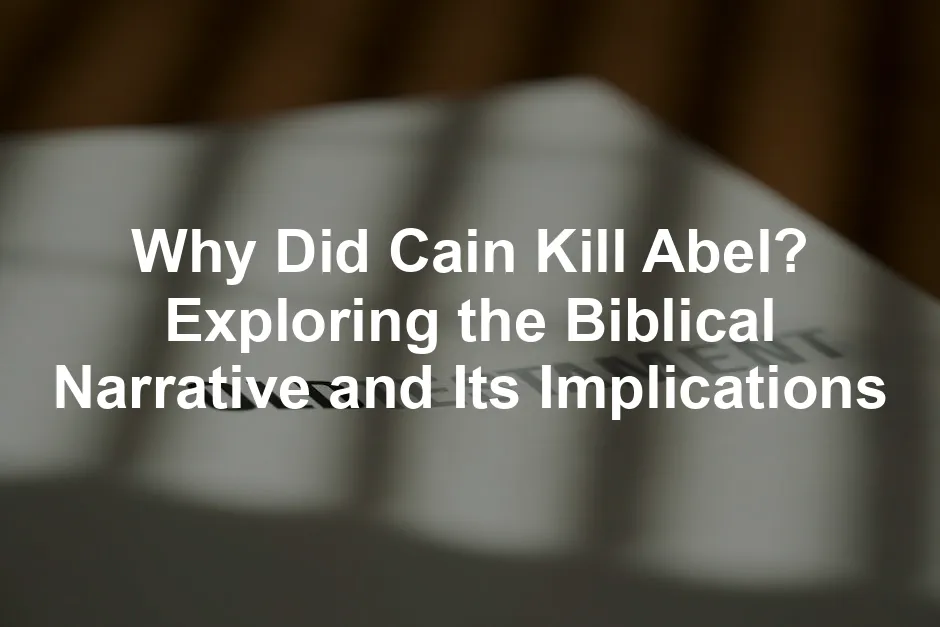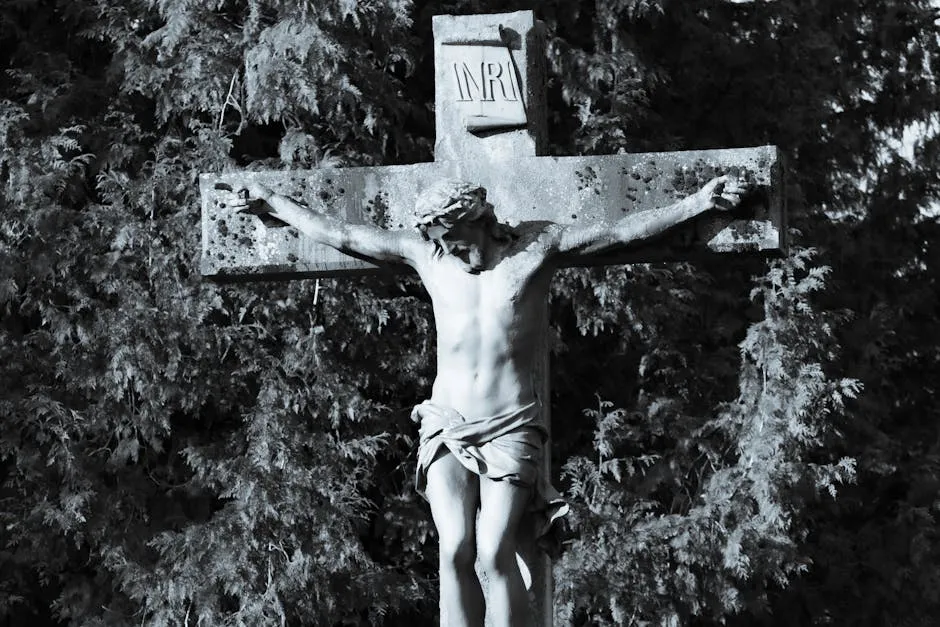
Why Did Cain Kill Abel? Exploring the Biblical Narrative and Its Implications
The Genesis Narrative
Overview of Cain and Abel’s Story
The story of Cain and Abel, found in Genesis 4:1-16, kicks off with a sibling rivalry that spirals into tragedy. Cain, the firstborn son of Adam and Eve, tilled the ground. His younger brother, Abel, became a shepherd. The brothers presented offerings to God from their respective labors. Cain brought fruits from his land, while Abel offered the finest lambs from his flock.
God, however, favored Abel’s offering over Cain’s. This divine preference ignited a firestorm of jealousy within Cain. Angry and dejected, Cain’s emotions spiraled out of control. Instead of introspecting, he succumbed to bitterness. Cain lured Abel into a field and committed the first murder in history.
This gruesome act marked a significant moment in biblical narrative, illustrating the depths of human emotion and moral failure. The scriptures notably highlight that Cain’s offering was rejected due to his intentions, suggesting that true sacrifice goes beyond mere material gifts.

Speaking of true sacrifice, if you’re looking for a profound spiritual read that dives deep into the essence of offering and intention, check out The Bible (Various Editions). It’s a timeless guide that encourages deep reflection on the heart behind our actions.
The passage serves as a cautionary tale about the consequences of unchecked emotions, jealousy, and the moral dilemmas faced by humanity. The ramifications of Cain’s actions extend beyond the immediate act of violence, illustrating a deep-seated conflict within the human psyche.
Theological Significance
In the biblical tradition, sacrifice holds great importance. It’s not just about giving but about intent and devotion. Cain and Abel’s offerings show this clearly. Abel’s offering of the finest lambs was accepted by God, while Cain’s fruits were rejected. This rejection implies a deeper meaning. God’s favor is not arbitrary but linked to the heart behind the gift. When Cain’s offering fell short, it sparked a chain reaction of emotions. His jealousy and anger led to tragic consequences. This story illustrates that divine favor is tied to our intentions. It raises questions about the nature of sacrifice and its theological implications, urging believers to reflect on their motivations. Understanding this narrative enriches one’s spiritual journey, reminding us that true offerings come from the heart, not just from duty.

If you’re intrigued by the psychological dimensions of emotions and relationships, consider reading Emotional Intelligence 2.0 by Travis Bradberry. It’s a great tool for understanding the emotional undercurrents that can lead to decisions like Cain’s.
Exploring Cain’s Motives
Jealousy and Resentment
Jealousy plays a starring role in Cain’s motives for murder. After God accepted Abel’s offering, Cain’s envy boiled over. He felt overshadowed by his brother’s success. This emotion is relatable to many. We’ve all felt that sting when someone else shines brighter. Cain’s anger isn’t just surface-level; it’s deeply rooted in insecurity. Rather than addressing his feelings, he allowed them to fester.
In 1 John 3:12, we see this clearly: “Not as Cain, who was of that wicked one and slew his brother.” The text highlights Cain’s wickedness but also his human vulnerability. His inability to manage his emotions led to a catastrophic decision. Instead of rejoicing in Abel’s favor, he chose violence. This story reflects a universal truth—unchecked jealousy can lead one down a dark path. It serves as a cautionary tale for us all.

To tackle jealousy head-on, you might find The Jealousy Cure: Learn to Trust, Overcome Possessiveness, and Save Your Relationship by Robert L. Leahy particularly enlightening. It provides strategies to navigate emotions that could otherwise lead to destructive outcomes.
The Role of Divine Rejection
God’s rejection of Cain’s offering is pivotal in this narrative. Scholars have long debated why God favored Abel’s offering over Cain’s. Some argue it reflects a divine favoritism that questions God’s fairness. Others suggest it speaks to the moral implications of Cain’s actions.
The act of rejection carries weighty implications. It wasn’t just about the offerings but about the hearts behind them. Cain’s offering lacked sincerity, while Abel’s was a true reflection of gratitude. Divine rejection forces Cain to confront his shortcomings. Instead of seeking redemption, he succumbs to despair. This illustrates a profound truth: rejection can either lead to growth or destruction. Cain’s choice to embrace the latter ultimately sealed his tragic fate.

Premeditation and External Influences
Some interpretations suggest that Cain’s motives were premeditated, influenced by external forces. Literary texts like the Pseudepigrapha introduce the idea of Satan manipulating Cain’s thoughts. They paint a picture of Cain wrestling with dark influences that cloud his judgment.
This dimension adds complexity to his character. Was he merely a victim of circumstance, or did he harbor intentions all along? When examining these texts, we find various narratives that enrich our understanding. For example, in The Life of Adam and Eve, Cain is portrayed as a character grappling with jealousy and external pressures. The combination of premeditation and external influences creates a nuanced view of human motivation. It prompts us to consider how outside forces can sway our actions, making Cain’s story a timeless reflection on the human condition.
The Act of Murder
Description of the Murder
In Genesis 4:8, the murder of Abel by Cain is chillingly straightforward. The verse states, “Cain said to Abel, ‘Let us go out to the field.’” There, Cain attacked and killed his brother. This act of fratricide shocked the world, marking the first murder in history. The method of murder remains a topic of speculation. Some believe Cain used a stone, while others suggest he might have resorted to a tool from his farming equipment. The brutality of the act highlights the extremes of human jealousy and rage. The violence depicted here sets a grim tone for the consequences of unchecked emotions. The act serves as a catalyst for understanding biblical violence, emphasizing the destructive power of envy. Cain’s actions not only led to Abel’s death but also to a curse that would change his life forever.

Immediate Aftermath
After the murder, God inquired about Abel’s whereabouts, prompting an infamous reply from Cain: “Am I my brother’s keeper?” This denial showcased Cain’s defiance and lack of remorse. God’s response was swift and severe. He pronounced a curse upon Cain, declaring that the ground would no longer yield its strength to him. This punishment transformed Cain into a restless wanderer, forever marked by his sin. The implications of this curse highlight the gravity of his actions. Cain’s life would now be defined by loss and exile, a fate shared by many in biblical narratives. This immediate aftermath illustrates a powerful lesson on accountability, revealing the dire consequences of violence and moral failure. The shift from a brotherly bond to a life of solitude serves as a poignant reminder of the tragedy that can arise from unchecked emotions.

And speaking of consequences, if you want a thought-provoking read on human psychology and moral dilemmas, check out The Anatomy of Violence: The Biological Roots of Crime by Adrian Raine. It sheds light on the underlying factors that can lead to such tragic outcomes.
Interpretations Across Cultures
Jewish Interpretations
Jewish tradition offers rich insights into the narrative of Cain and Abel. Rabbinic literature often emphasizes themes of guilt, punishment, and the possibility of redemption. Scholars like Rashi interpret Cain’s actions as a profound moral failing driven by jealousy. The Talmud expands on this, suggesting that Cain felt threatened by Abel’s piety. This rivalry reflects broader societal tensions between agricultural and pastoral communities. Guilt permeates the story, as Cain grapples with the weight of his transgression. The concept of repentance emerges strongly in Jewish thought. Cain’s curse is seen not just as punishment but as an opportunity for personal growth. The narrative serves as a cautionary tale about the dangers of unchecked emotions and the importance of self-awareness. This multifaceted interpretation highlights how the story resonates with contemporary themes of accountability and moral responsibility within Jewish tradition.

Christian Perspectives
In Christian theology, the story of Cain and Abel takes on profound significance. The New Testament references this narrative, particularly in Hebrews 11:4, which underscores Abel’s faith in presenting a better sacrifice than Cain. This distinction raises essential theological questions about sin and redemption. Cain represents humanity’s struggle with jealousy and sin, while Abel embodies righteousness and faith. The narrative emphasizes the consequences of sin, illustrating that Cain’s actions stem from his refusal to confront his emotions. In 1 John 3:12, Cain’s murder of Abel is presented as a stark warning against hatred and moral failure. This interpretation encourages believers to reflect on the nature of sin and its impact on relationships. The story serves as a foundational lesson about the importance of humility and the dangers of harboring negative emotions. Ultimately, it highlights the path to redemption through faith and self-reflection, encouraging a deeper understanding of spiritual growth within the Christian faith.

Islamic Perspectives
In Islamic tradition, the story of Cain and Abel is mirrored in the Quran, where they are known as Qābīl and Hābīl. The narrative emphasizes jealousy and the sanctity of life, echoing themes found in the Biblical account. The Quranic narrative, particularly in Surah Al-Ma’idah (5:27–31), highlights the emotional turmoil leading to the tragic act. It illuminates Cain’s internal conflict, portraying him as a figure consumed by envy and despair.
The moral lessons presented are profound. The story serves as a cautionary tale about the consequences of sin and moral failure. It warns against allowing jealousy to fester. The Quran teaches that such unchecked emotions can lead to devastating outcomes, as seen when Qābīl succumbs to his darker impulses. The themes of accountability and the seriousness of murder are emphasized, reinforcing the idea that every action has repercussions. These moral lessons resonate deeply within Islamic teachings, showcasing the narrative’s relevance across cultures and time, providing insights into human behavior and the importance of self-control.
Legacy and Cultural Impact
Influence on Literature and Art
The story of Cain and Abel has left an indelible mark on literature and art throughout history. Its themes of jealousy, betrayal, and moral conflict have inspired countless artistic representations. Notable examples include Peter Paul Rubens’ dramatic painting Cain Slaying Abel, which captures the raw emotion of the moment.

In literature, the narrative has influenced works by writers like John Steinbeck in East of Eden, where the sibling rivalry is reimagined in a modern context. The cultural legacy of Cain and Abel extends to various artistic forms, including poetry and music, reflecting the timeless human struggle with envy and moral dilemmas. These artistic representations not only immortalize the story but also invite audiences to reflect on their own relationships and the consequences of their actions. The narrative’s ability to resonate with diverse audiences speaks to its enduring significance in cultural discussions around morality and human nature.

For those who appreciate the arts, consider grabbing a stunning Cain Slaying Abel by Peter Paul Rubens (Art Print). It’s a powerful reminder of the story’s emotional depth.
Moral Lessons Drawn from the Narrative
The story of Cain and Abel continues to offer relevant moral lessons applicable to contemporary issues. It serves as a poignant reminder of the dangers of jealousy and resentment in human relationships. Cain’s inability to manage his feelings led to the tragic murder of his brother, a fateful decision still echoed in today’s conflicts.

This narrative teaches us about conflict resolution and the importance of addressing our emotions constructively. It emphasizes the need for self-reflection and personal accountability. The lessons drawn from this ancient story encourage individuals to foster compassion and understanding, rather than allowing jealousy and anger to dictate their actions. As society grapples with similar moral dilemmas, the story remains a vital source of wisdom on the human condition and the importance of nurturing healthy relationships.
Conclusion
The story of Cain and Abel serves as a powerful reminder of the dangers of jealousy and the consequences of unchecked emotions. Cain’s feelings of resentment, fueled by God’s favoritism towards Abel, led to a tragic and irreversible act. This narrative illustrates how envy can twist the human heart, prompting destructive choices. By examining Cain’s motives and the implications surrounding his actions, we gain deeper insights into the complexities of human behavior. This tale resonates across time, prompting reflection on the nature of sin, redemption, and the importance of compassion in our lives. It urges us to confront our darker emotions and foster understanding rather than hostility. Ultimately, the narrative serves as a poignant reminder that love and acceptance should triumph over jealousy and anger.

If you’re interested in exploring themes of self-acceptance and personal growth, The Gifts of Imperfection by Brené Brown is a fantastic read. It encourages embracing who you are and letting go of societal expectations.
Why did God reject Cain’s offering?
Various interpretations exist regarding God’s reasons for rejecting Cain’s sacrifice. Some suggest that it was due to the quality of Cain’s offering, which lacked the best of his produce. Others argue that God rejected it because of Cain’s poor intentions. The emphasis is on the heart behind the offering, not just the act itself. This highlights the importance of sincerity in our spiritual practices.
What does the story of Cain and Abel teach us today?
The narrative imparts valuable moral lessons relevant to modern life. It warns against the perils of jealousy and resentment, urging individuals to resolve conflicts constructively. The story emphasizes the need for forgiveness and understanding in human relationships, offering a timeless reminder that unchecked emotions can lead to dire consequences.
How is Cain viewed in different religious traditions?
Cain is portrayed differently across religious perspectives. In Judaism, he is often seen as a figure embodying guilt and punishment. Christianity views Cain through the lens of sin and moral failure, while Islam emphasizes the moral lessons derived from his actions. Each tradition offers a unique interpretation that enriches the understanding of this complex character.
What cultural references exist about Cain and Abel?
The story of Cain and Abel has profoundly influenced literature, art, and popular culture. From Shakespeare to modern films, the themes of sibling rivalry and moral conflict continue to inspire creative works. Notable examples include Peter Paul Rubens’ painting ‘Cain Slaying Abel’ and John Steinbeck’s novel ‘East of Eden,’ which reimagines the tale in a contemporary context.
How does the narrative of Cain and Abel relate to the concept of sin?
The story serves as a foundational example of sin and moral failure in religious texts. It illustrates how unchecked emotions can lead to devastating actions, highlighting the need for self-awareness and accountability. Cain’s narrative prompts readers to reflect on their own choices and the broader implications of sin in human relationships.
Please let us know what you think about our content by leaving a comment down below!
Thank you for reading till here 🙂
All images from Pexels




